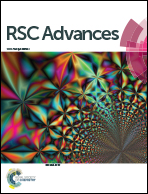Anti-proliferative activity of the combination of salan Ti(iv) complexes with other organic and inorganic anticancer drugs against HT-29 and NCI-H1229 cells: synergism with cisplatin†
Abstract
Two diaminobis(phenolato) Ti(IV) complexes were separately combined with azatoxin, camptothecin or cisplatin and underwent in vitro cytotoxicity analysis toward HT-29 and NCI-H1229 cancer cell lines. The methylated salan derivative exhibited synergistic effects with cisplatin at varying ratios toward both lines, when the compounds were administered fresh and simultaneously, implying great medicinal potential.


 Please wait while we load your content...
Please wait while we load your content...